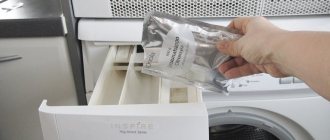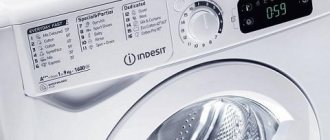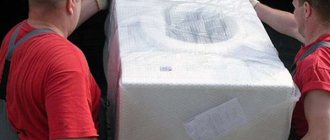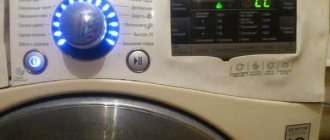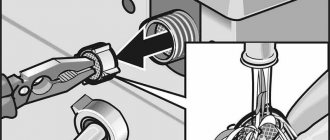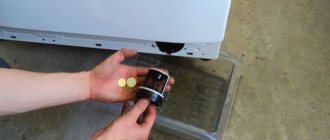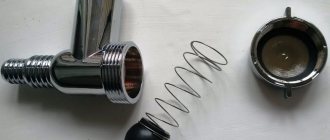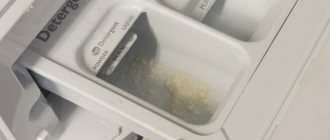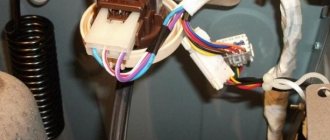Synchronous motors
It has been known since school days that when magnets are brought close, they attract or repel. The first case occurs at opposite magnetic poles, the second - at like ones. We are talking about permanent magnets and the magnetic field they constantly create.
In addition to those described, there are variable magnets. Everyone remembers an example from a physics textbook: the picture shows a magnet in the shape of a horseshoe. Between its poles there is a frame made in the shape of a horseshoe and having half rings. Current was supplied to a horizontally located frame.
Since the magnet repels like poles and attracts unlike poles, an electromagnetic field arises around this frame, which turns it vertically. As a result, it receives a current that is opposite in sign to the first case. The changing polarity rotates the frame and returns it to the horizontal plane.
The operation of a synchronous electric motor is based on this principle.
In a real circuit, current is supplied to the windings of the rotor, which is a frame. The source that creates the electromagnetic field is the windings. The stator performs the functions of a magnet.
It is also made of windings or a set of permanent magnets.
The rotor speed of the electric motor of the described type is the same as the current supplied to the winding terminals, i.e. they work synchronously, which gives the electric motor its name.
Engine test
If you find an engine from a Vyatka-automatic machine in the garage that has been collecting dust on the shelves for a long time, and you want to use it on the farm, but you don’t know whether it’s working, diagnose the device. To test an electric motor, you will need the simplest multimeter and a special digital meter for power, voltage, and current. You can purchase devices in specialized stores or on the Internet.
To begin with, it is better to measure the resistance of the motor windings with a multimeter. Switch the tester to the appropriate mode and alternately lean the probes against pairs of contacts. Normally, the indicators on the device screen will be as follows:
- when measuring resistance between terminals 1 and 5 - 23.2-26.8 Ohms;
- between 1 and 2 contacts – 8-9.2 Ohms;
- 4 and 3 – 51.1-58.9 Ohms;
- 4 and 6 – 51.1-58.9 Ohms;
- between 3 and 6 – 71.6-82.4 Ohms.
If the winding resistance meets the standard values, the motor can usually be used for secondary purposes. However, it is better to perform a more complete diagnosis and check how the motor holds and copes with loads, whether it overheats, and what speed it produces. For these purposes, you will need a special power, voltage and current meter.
Ideally, the measurement results at low and high speeds should be the same both when the rotor rotates clockwise and counterclockwise. If everything is normal, then when the engine accelerates to 370 rpm, the measuring device should produce approximately the following indicators:
- voltage 220-230 Volts;
- power – 290-310 Watts (the figure depends on the specific engine model, perhaps your electric motor will be more powerful);
- current strength - 1.4-1.5 Amperes.
As the RPM increases, the results should be similar. If the electric motor is normal, you can connect it according to the diagram described above. It can become the basis for creating many useful household devices: an emery or lathe, grain or apple crushers, lawn mowers, concrete mixers, etc.
Interesting:
- Wood lathe from a washing machine engine
- Technical characteristics of the washing machine motor
- Russian-made washing machines
- Do-it-yourself emery from a washing machine
- How to make a machine from a washing machine engine
- How to connect a motor from an old washing machine?
Reader comments
- Share your opinion - leave a comment
How does an asynchronous motor work?
To understand the principle of its operation, we recall the same picture as in the previous example: a frame (but without half rings) is placed between the magnetic poles. The magnet is made in the shape of a horseshoe, the ends of which are connected.
We begin to slowly rotate it around the frame, watching what is happening: until a certain moment, no movement of the frame is observed. Then, at a certain angle of rotation of the magnet, it begins to rotate behind it at a speed less than the speed of the latter. They work asynchronously, which is why the motors are called asynchronous.
In a real electric motor, a magnet is a winding placed in the stator slots to which current is supplied. The rotor is a frame. In its grooves there are short-connected plates. That's what they call it - short-circuited.
How to remove an asynchronous motor?
The wires connecting the asynchronous motor and the capacitor should not be cut. The battery is pulled out along with the engine. There are many types of batteries. It may look like a metal or plastic box. As a rule, the battery is a sealed structure. It contains one or more capacitors, the connection between which is parallel.
The connection diagram of the unit is also different. The winding can be connected directly to the network. Another modification involves passing current through a capacitor. The existing scheme cannot be changed. It needs to be connected to the power supply, and the asynchronous motor will begin to rotate.
Do not touch motor parts until the capacitor is discharged.
Advantages of asynchronous motors for washing machines
The electric motor that rotates the drum is the heart of the washing machine. The drive in the very first versions of the machines was belts that rotated the container with laundry.
But today the asynchronous unit, which converts electricity into mechanical energy, has been significantly improved.
Most often, washing machine circuits contain asynchronous electric motors, consisting of a stator, which does not move and serves as both a magnetic circuit and a supporting structure, and a moving rotor that rotates the drum. An asynchronous motor operates due to the interaction of the magnetic alternating fields of these nodes.
We recommend:
Asynchronous motors are divided into two-phase, rare, and three-phase.
The advantages of asynchronous units include:
- simple design;
- simple maintenance, including replacement of worn bearings and
- periodic lubrication of the electric motor;
- silent operation;
- relative cheapness.
- Of course, there are also disadvantages:
- low efficiency;
- big sizes;
- low power.
Read also: The invention of electricity in the 19th century
Such motors are usually installed on inexpensive models.
Grinder
Any man can do it if he has a motor from an Indesit, Ariston, or any other model automatic washing machine.
When attaching a sharpening stone to an engine, the manufacturer may encounter a problem: the diameter of the hole in the stone does not match the diameter of the engine shaft. It is recommended to use an additional part, which is turned on a lathe. Making such an adapter is not difficult. The main thing is to know the shaft diameter. Not only an adapter should be available. You also need to prepare a nut, washer and a special bolt.
The thread on the nut is cut depending on which direction the engine will rotate. To rotate clockwise, a left-hand thread is made, and counterclockwise, a right-hand thread is made. If you do not adhere to this rule, the stone will begin to fly off, as the process begins to unwind.
If there is a nut with a thread that is not suitable in the direction, then you can change the direction of rotation. For this purpose, the winding wires are swapped.
It is possible to set the motor to reverse rotation without using a capacitor. After the working winding is connected to a voltage of 220 V, the stone is sharply rotated in the desired direction.
The speed of rotation of the grindstone should not exceed 3000 per minute. Otherwise the stone will burst.
When using such a unit at home, experts advise using a motor whose frequency is 1000 rpm.
A homemade sharpening machine must be equipped with additional elements. They will serve as protection from dust and stone fragments during work.
A piece of metal about 2 mm thick can be used as a casing.
Connection diagram
Features that need to be taken into account to connect the electric motor from the washing machine to a 220 V network:
- the connection diagram demonstrates that the motor operates without a starting winding;
- There is also no starting capacitor in the connection diagram - it is not required for starting. But it is necessary to connect the wires to the network strictly in accordance with the diagram.
This video will help you figure it out:
Video: How to connect a motor from a washing machine to 220
The main thing is to connect strictly in accordance with the wire connection diagram.
No wires (2 white) are needed to connect – engine speed meter. The others are the red and brown wires (3 and 4) going to the stator, as well as the gray and green (1 and 2) going to the brushes, as can be seen from the connection diagram and must be connected correctly.
In the motor connection diagram, the stator windings are connected in series.
220V is connected to the red wire of the winding, as indicated in the connection diagram. One brush is connected to the end of the next winding.
The other, as required by the connection diagram, is connected to 220 V. The engine is ready for operation, but it rotates in one direction. To turn it in the opposite direction, you need to swap the brushes.
Connecting a motor from a washing machine - diagram
Knowing how the motor of an automatic washing machine is connected is necessary to check the proper operation, or to use it for other purposes. Not all motors can be tested and used in household devices. But most are quite easy to connect - the main thing is to know the principle of operation and the circuit.
Modern washing machines use three types of motors:
- collector;
- asynchronous;
- direct drive with inverter control.
Brushed motor
Collector
This is the most common motor. According to statistics, it costs 85% of washing machines.
Its advantages:
- express;
- easy to manage.
Do you wash your shoes in the machine?
Oh yes! No
The main disadvantage of these motors is the brush assembly. With average use, it lasts for 8-10 years. Then a replacement is needed. In addition, the brushes wear down and coal dust settles on various parts in the machine.
Quite often, this will lead to operational problems that will be difficult to identify. Brush dust allows electricity to pass through and causes current leakage, which leads to malfunctions.
Recently, there has been a tendency to move away from such engines. But for inexpensive models, commutator motors are indispensable.
Asynchronous
Less common option. The advantages include the absence of brushes and associated problems.
Asynchronous motor
The disadvantages are the following:
Because of this, they are not so widely used. There are single- and three-phase asynchronous motors. To start the first, a starting capacitor of a certain capacity is used. For three-phase, a complex control system using an inverter is used.
Direct drive
In essence, this is an innovative product that was developed by LG, and is very widely used on the washing machine models that it produces. The main advantage of this engine is the absence of a drive belt. Since the motor is mounted directly on the drum shaft and rotates it.
LG Direct Drive Motor
Thanks to this, there are no friction losses, as well as additional vibration. The company claims that machines with direct drive motors are less noisy, and therefore more comfortable to operate.
The disadvantage of this solution is complex and expensive management. It is carried out by converting alternating current into direct current. Because of this, such motors are called inverter motors. Electronic modules are very complex and cannot always be repaired.
Since commutator motors are the most common, we will consider connecting them.
Such devices have the following elements:
- stator;
- rotor;
- tachometer generator;
- thermal fuse (in some models);
- grounding
It is necessary to identify all the contacts in the block.
Motor elements
First of all, we look at a couple of wires from - they are usually red and the thinnest. The location is easy to determine visually.
We define the rotor in the same way. Wires go from the motor brushes directly to the block.
If there is no temperature sensor, then the remaining two contacts are the stator. In BEKO washing machines, the grounding is located in the block. In others it is located separately.
The general connection diagram is shown in the figure below.
Motor connection diagram
As you can see, you first need to make a jumper between the rotor and stator. Then apply 220 volts to the remaining two. But if you do this, and the engine is not secured, then it will simply “take off”, because it will immediately gain maximum speed. The fact is that in a washing machine the speed is controlled using a tachometer generator.
Motor connection diagram in an old washing machine
Everything is more serious here. You need to find 2 pairs of pins that match each other using a multimeter (toaster). To do this, fix the device on any of the terminals and find the paired one using a probe. The two remaining pins will be the second pair automatically.
Now determine the location of the working and starting windings by measuring the resistance. The starting point (PO), which creates the starting torque, is found by its higher resistance. The disturbance winding (OB) creates a magnetic field.
